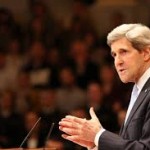
Complications at the Second Round of P5+1 Talks
By Joshua Kyle Miller
At the conclusion of negotiations on Iran’s nuclear program held in Geneva from November 7th to the 9th, US Secretary of State John Kerry announced that the talks had “narrowed differences” between the two sides and “made significant progress”.
It seemed all of the P5+1 countries were on board as they had all tacitly agreed with a draft. During a visit to Abu Dhabi on Monday morning, Secretary Kerry told reporters that the P5+1 had been “unified on Saturday when we presented our proposal to the Iranians.”
The situation changed as France highlighted a few reservations amid the talks, specifically referring to Iran’s right to enrichment and placing tighter restrictions on the heavy-water reactor at Arak. Foreign Minister Laurent Fabius warned that a rush to an agreement would be a “fool’s game.” Not surprisingly, President Rouhani and Foreign Minister Zarif were displeased with the objection, and the other P5+1 members expressed discontent.
Secretary Kerry contended that “people need to stop and think about what happens each day now that you don’t have an agreement…Iran will continue to reach, and Iran will continue to put centrifuges in, and Iran will continue its program.”
To France and to other skeptics, the current draft agreement covers all the major demands of the world powers on transparency measures required by the IAEA, but lacks measures to prevent an Iranian “breakout” capability and ensure Iran remains a non-nuclear weapon state. To assuage their fears, Secretary Kerry declared that “we are acting in the interests of our country and of the globe,” and will continue to keep sanctions in place as talks continue.
Moreover, in addressing France’s objection to Iran’s heavy-water reactor at Arak, it should be noted that Iran does have certain rights under the Non-Proliferation Treaty. Though heavy water reactors are indeed “optimal” for producing weapons-grade plutonium and the international community should exercise a degree of skepticism, such reactors are, in fact, permitted for peaceful uses under the NPT.
Furthermore, Tehran illustrated a measure beyond its commitment to the Safeguard Agreement when Ali Akbar Salehi, head of the Atomic Energy Organization of Iran, met with IAEA Director General Yukiya Amano on November 11th and the latter announced that Iran had accepted the IAEA’s demand to inspect the Arak facility. Finally, Iran does not possess reprocessing or plutonium separation capacities at Arak, and has repeatedly stated that it does not seek to achieve such capabilities.
Despite the concerns raised during the talks, Foreign Minister Zarif espoused a positive outlook at the end of the negotiations. “We are committed to constructive engagement. Interaction on equal footing key to achieve shared objectives.” Secretary Kerry also stated that negotiators had been “very, very close… extremely close” to agreeing to a deal.
Addressing the fears of skeptics and maintaining the impetus of the negotiations is of upmost importance in ensuring success of negotiations. The P5+1 and Iran will convene once again on November 20th. It is imperative that the P5+1 be unified in its negotiating platform and not risk squandering a crucial opportunity.







[…] Complications at the Second Round of P5+1 Talks Joshua Kyle Miller […]